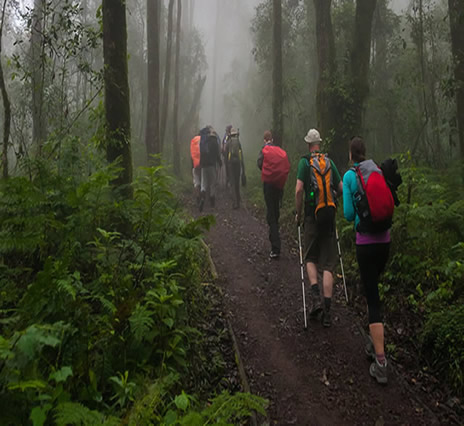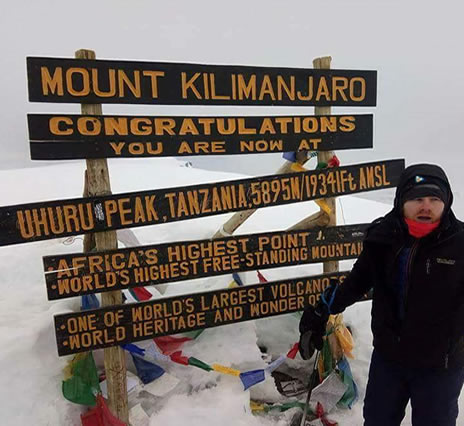
Kilimanjaro is a comparatively safe mountain trek. No technical climbing skills are required to reach the summit, the trails are well-trodden, and the evacuation procedures generally well-understood. A staggering 40-50,000 people climb Kilimanjaro every year, and cases of serious illness or death are very rare.
That said, Kilimanjaro is considered an extreme altitude (5,500m+) mountain climb and climbers face the same risks as on other high-altitude climbs.
RisksAltitude
Altitude sickness is the most obvious and most important risk to be aware of when planning a Kilimanjaro climb. Indeed, there's a case to be made that altitude is more of a risk on Kilimanjaro than on most other high altitude climbs, as several of the popular routes to the summit encourage a rapid ascent (far faster than what is the norm on most climbs in the Andes or Himalayas, by way of comparison).
Understanding the risks posed by altitude and how best to manage them is essential before you even set foot on the mountain, especially if Kilimanjaro is your first high-attitude climb, as it is for many.
WeatherKilimanjaro experiences significant seasonal shifts in its weather, which all climbers should be aware of. There are real risks in climbing out of season. Kilimanjaro receives very heavy rainfall during the long (March-May) and short (Nov) wet seasons, which can easily end a climb early. Sun, too, can pose a risk on Kilimanjaro – sun burn and even sun stroke is not uncommon at altitude.
General injuryAs on any mountain climb or remote adventure, there's a risk that you'll suffer injury on Kilimanjaro. While the typical climbers' hazards – crevasses, ice walls, rock fall – are much less of a risk than they are on other high altitude climbs, injury can still occur even on Kilimanjaro's less-hazardous trails.
Good Kilimanjaro operators will provide at least a first-aid trained leader and comprehensive medical kit, so in the event of minor injury (cuts, scrapes etc), climbers can be treated on the mountain and continue their climb. More serious injury will require evacuation (see below).
That being said, from our experience it is rarely dramatic injury or sickness that prevents climbers from summiting Kilimanjaro comfortably, but seemingly minor ailments such as foot blisters!
Pre-existing medical conditionsIf you suffer from cardiac or pulmonary related issues it's essential to consult your doctor before you consider climbing Kilimanjaro.
It goes without saying that you must be fit to climb Kilimanjaro. A good fitness programme, in and out of the gym and ideally involving extensive hill training, is most important.
Drops and exposurewe're occasionally asked by prospective climbers if they will encounter any steep drops while climbing Kilimanjaro.
There's actually very little exposure (mountain parlance for drops) on Kilimanjaro, unless you actively seek it out. Some of the more remote, technical routes do involve some precarious climbs, but not the well-established trekking routes. A partial exception are the western wilderness routes (Shira, Lemosho) and Machame, as these routes require you to climb the infamous Barranco Wall. This is a short but moderately steep climb, which can be precarious in poor weather. Most climbers, however inexperienced, will not struggle with Barranco, despite its reputation. Climbers should also be aware that some of Kilimanjaro's camps, such as Barafu, are somewhat exposed.
Kilimanjaro's summit approach does not involve ropes and there is no crevasse danger.
Evacuation on KilimanjaroMountain evacuation is always complicated, and Kilimanjaro is no exception. Thankfully, it is rare that climbers need to be evacuated from Kilimanjaro due to severe altitude sickness or injury. Much more common is mild altitude sickness triggering a precautionary evacuation.
Evacuation from Kilimanjaro is initially on foot (if able) or by stretcher, until the highest point that can be reached by a rescue car (typically, this is below Mandara Hut on Shira Plateau or at Rongai Gate). The National Park authorities provide a rescue car for these situations, and there are ranger posts on the mountain with radio contact to the park authority headquarters. Once in a vehicle, the sick climber can then be transferred directly to a hospital (KCMC Hospital in Moshi or ALMC Hospital, AAR Clinic or Aga Khan Clinic in Arusha), or if, as is often the case, they are already recovering from altitude sickness, to their lodge.
There are a number of quick descent routes on Kilimanjaro meaning that evacuation can be completed in a day from just about any point on the mountain. A well-staffed climb team should include sufficient staff to allow an assistant or lead guide to travel with the sick climber without affecting the rest of the group.
Air evacuation by helicopter from Kilimanjaro is possible up to an altitude of 4,700m (Kibo Hut), but the available rescue sites are fairly limited and weather-dependent, meaning it is very rare that air rescue would be resorted to over evacuation on foot or by stretcher (to give you an indication of how rare, we offer complimentary air rescue cover to all of our climbers and haven't once had to call on it).
Choosing an operator and guideChoosing a good climb team and operator is the most important decision you'll make when planning your Kilimanjaro climb as far as your safety is concerned.
A poor (or poorly-paid) guide will rush you to the summit and back down in order to squeeze in more climbers during the short but busy climbing seasons. Many local Kilimanjaro outfitters encourage rapid ascents, which is the main reason why the failure-to-summit rate on Kilimanjaro is so much higher than other comparable mountain climbs, despite the trails being by most measures easier.
Our guide to choosing an operator suggests some questions that you should ask any operator you're thinking of booking a climb with. The most important points to query are the ratio of staff to climbers (at a minimum, demand 3:1) that they provide; the length of the routes they use; and the training their guides have received.
Medical equipmentYou should always ask your climb operator what level of first aid supplies and medical equipment they provide. At the very least you should expect a first aid trained guide and comprehensive first aid kit. Larger groups may want to travel with an experienced doctor and full doctor's kit.
There is a limit to what's needed on the mountain, of course. When we started organising Kilimanjaro climbs 25 years ago, it was common for groups to travel with only a simple first aid kit and, if they were lucky, a first-aid trained leader. The situation has improved, thankfully, but perhaps more than was needed, for recent years have seen something of a medical arms race among Kilimanjaro operators, with each trying to distinguish themselves from the other by adding ever-more specialist medical equipment. The truth of the matter is that some of these items, such as portable defibrillators, have quite limited utility on Kilimanjaro. We do not recommend paying a supplement for such equipment, if asked, though if it's included as standard by your climb operator than it may bring additional peace of mind. Similarly, portable oxygen is not essential – given that quick evacuation is always possible from Kilimanjaro – but can be reassuring (we always carry it, though very rarely use it).


